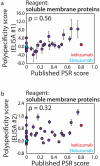Highly sensitive detection of antibody nonspecific interactions using flow cytometry
- PMID: 34313552
- PMCID: PMC8317921
- DOI: 10.1080/19420862.2021.1951426
Highly sensitive detection of antibody nonspecific interactions using flow cytometry
Abstract
The rapidly evolving nature of antibody drug development has resulted in technologies that generate vast numbers (hundreds to thousands) of lead antibody candidates during early discovery. These candidates must be rapidly pared down to identify the most drug-like candidates for in-depth analysis of their safety and efficacy, which can only be performed on a limited number of antibodies due to time and resource requirements. One key biophysical property of successful antibody therapeutics is high specificity, defined as low levels of nonspecific binding or polyspecificity. Although there has been some progress in developing assays for detecting antibody polyspecificity, most of these assays are limited by poor sensitivity or assay formats that require proprietary antibody surface display methods, and some of these assays use complex and poorly defined polyspecificity reagents. Here we report the PolySpecificity Particle (PSP) assay, a sensitive flow cytometry assay for evaluating antibody nonspecific interactions that overcomes previous limitations and can be used for evaluating diverse types of IgGs, multispecific antibodies and Fc-fusion proteins. Our approach uses micron-sized magnetic beads coated with Protein A to capture antibodies at extremely dilute concentrations (<0.02 mg/mL). Flow cytometry analysis of polyspecificity reagent binding to these conjugates results in sensitive detection of differences in nonspecific interactions for clinical-stage antibodies. Our PSP assay strongly discriminates between antibodies with different levels of polyspecificity using previously reported polyspecificity reagents that are either well-defined proteins or highly complex protein mixtures. Moreover, we also find that a unique reagent, namely ovalbumin, results in the best assay sensitivity and specificity. Importantly, our assay is much more sensitive than standard assays such as ELISAs. We expect that our simple, sensitive, and high-throughput PSP assay will accelerate the development of safe and effective antibody therapeutics.
Keywords: Developability; affinity; bispecific; multispecific; mAb; IgG; Fc; Fab; non-specific; nonspecific; off-target binding; polyreactivity; specificity.
Conflict of interest statement
No potential conflict of interest was reported by the author(s).
Figures









Similar articles
-
Toward Drug-Like Multispecific Antibodies by Design.Int J Mol Sci. 2020 Oct 12;21(20):7496. doi: 10.3390/ijms21207496. Int J Mol Sci. 2020. PMID: 33053650 Free PMC article. Review.
-
Reduction of therapeutic antibody self-association using yeast-display selections and machine learning.MAbs. 2022 Jan-Dec;14(1):2146629. doi: 10.1080/19420862.2022.2146629. MAbs. 2022. PMID: 36433737 Free PMC article.
-
Addressing polyspecificity of antibodies selected from an in vitro yeast presentation system: a FACS-based, high-throughput selection and analytical tool.Protein Eng Des Sel. 2013 Oct;26(10):663-70. doi: 10.1093/protein/gzt047. Epub 2013 Sep 17. Protein Eng Des Sel. 2013. PMID: 24046438
-
Bispecific antibody target pair discovery by high-throughput phenotypic screening using in vitro combinatorial Fab libraries.MAbs. 2021 Jan-Dec;13(1):1859049. doi: 10.1080/19420862.2020.1859049. MAbs. 2021. PMID: 33487120 Free PMC article.
-
Full-length recombinant antibodies from Escherichia coli: production, characterization, effector function (Fc) engineering, and clinical evaluation.MAbs. 2022 Jan-Dec;14(1):2111748. doi: 10.1080/19420862.2022.2111748. MAbs. 2022. PMID: 36018829 Free PMC article. Review.
Cited by
-
Developability assessment at early-stage discovery to enable development of antibody-derived therapeutics.Antib Ther. 2022 Nov 11;6(1):13-29. doi: 10.1093/abt/tbac029. eCollection 2023 Jan. Antib Ther. 2022. PMID: 36683767 Free PMC article. Review.
-
Machine learning to predict continuous protein properties from binary cell sorting data and map unseen sequence space.Proc Natl Acad Sci U S A. 2024 Mar 12;121(11):e2311726121. doi: 10.1073/pnas.2311726121. Epub 2024 Mar 7. Proc Natl Acad Sci U S A. 2024. PMID: 38451939 Free PMC article.
-
Unsupervised evolution of protein and antibody complexes with a structure-informed language model.Science. 2024 Jul 5;385(6704):46-53. doi: 10.1126/science.adk8946. Epub 2024 Jul 4. Science. 2024. PMID: 38963838 Free PMC article.
-
Co-optimization of therapeutic antibody affinity and specificity using machine learning models that generalize to novel mutational space.Nat Commun. 2022 Jul 1;13(1):3788. doi: 10.1038/s41467-022-31457-3. Nat Commun. 2022. PMID: 35778381 Free PMC article.
-
Antibodies with Weakly Basic Isoelectric Points Minimize Trade-offs between Formulation and Physiological Colloidal Properties.Mol Pharm. 2022 Mar 7;19(3):775-787. doi: 10.1021/acs.molpharmaceut.1c00373. Epub 2022 Feb 2. Mol Pharm. 2022. PMID: 35108018 Free PMC article.
References
-
- Dyson MR, Masters E, Pazeraitis D, Perera RL, Syrjanen JL, Surade S, Thorsteinson N, Parthiban K, Jones PC, Sattar M, et al. Beyond affinity: selection of antibody variants with optimal biophysical properties and reduced immunogenicity from mammalian display libraries. mAbs. 2020;12:1829335. doi:10.1080/19420862.2020.1829335. - DOI - PMC - PubMed
-
- Shan L, Mody N, Sormani P, Rosenthal KL, Damschroder MM, Esfandiary R. Developability assessment of engineered monoclonal antibody variants with a complex self-association behavior using complementary analytical and in silico tools. Mol Pharm. 2018;15:5697–710. doi:10.1021/acs.molpharmaceut.8b00867. - DOI - PubMed
Publication types
MeSH terms
Substances
Grants and funding
LinkOut - more resources
Full Text Sources
Other Literature Sources
Miscellaneous
